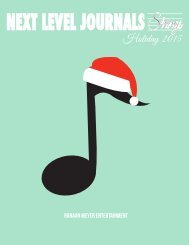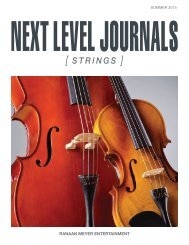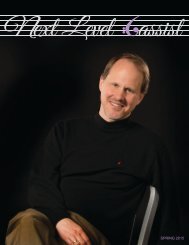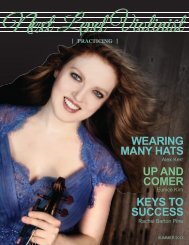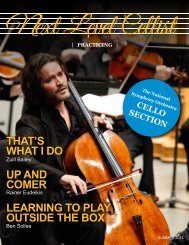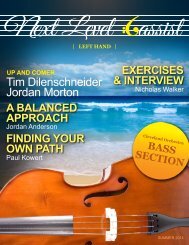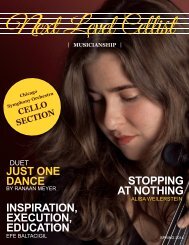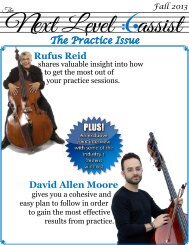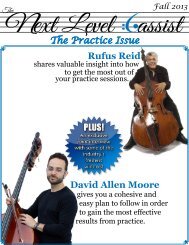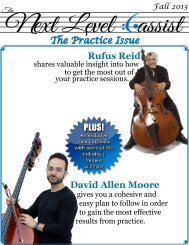Next Level Bassist Musicality Issue
Articles by Sarah Hogan and John Patitucci, Spotlight on the Pittsburgh Symphony, Double Stop Strum by Ranaan Meyer
Articles by Sarah Hogan and John Patitucci, Spotlight on the Pittsburgh Symphony, Double Stop Strum by Ranaan Meyer
You also want an ePaper? Increase the reach of your titles
YUMPU automatically turns print PDFs into web optimized ePapers that Google loves.
Bard College Conservatory of Music with the American Symphony Orchestra announces the<br />
american symphony orchestra<br />
Double Bass Scholarship<br />
A full merit scholarship covering tuition, room and board at the Bard Conservatory.<br />
Conservatory Double Bass Faculty<br />
Leigh Mesh<br />
Marji Danilow<br />
845-758-7604 bard.edu/conservatory conservatoryadmission@bard.edu<br />
What I want to hear is the different roles of the notes in different parts<br />
of the bar. (See example) There are lots of elements to that seemingly<br />
simple pattern. If you can’t create that sort of groove, you don’t have<br />
musicality yet!<br />
?<br />
4<br />
œ<br />
Call<br />
Response Repeat Repeat<br />
bœ<br />
j œ œ œ œ bœ<br />
j œ<br />
Once you have really crafted your internal rhythm, you can begin<br />
thinking about all the styles of music out there where your rhythm<br />
needs to be flexible. This can be classical music, or it can even be really<br />
sophisticated forms of jazz. You’ll hear this called “rubato,” but I think<br />
that can be misleading. This Italian word, meaning “robbing” time, can<br />
lead a musician into thinking just stretching out your favorite musical<br />
moments is enough, but of course you’ve got to make up for that time<br />
somewhere else. What does that really mean, though?<br />
Listen to any record of Pablo Casals or Oscar Shumsky playing Bach<br />
- they have the rhythmic solidity of a drummer. The real markers,<br />
the bar lines, are where the pulse is completely stable, but the music<br />
between the bar lines can change all over the place. If you change<br />
anything about rhythm, it’s important to remain grounded and come<br />
back to that groove you worked so hard to develop. The next step that<br />
you can research is what I call “playing over the top of the tempo,” and<br />
it’s something you can easily hear in stride piano playing. A pianist can<br />
have the left hand in time with the right hand stretched out over that.<br />
There’s an even freer way of approaching time I experience all the time<br />
in Wayne Shorter’s band - it’s the essence of breathing together and<br />
feeling our way through the tempo as a group without a strict pulse at<br />
all. We are creating music purely by listening and letting the harmonies<br />
and the sounds guide when to change the music. This is a real sign<br />
of trust, and I think you can only achieve this in groups where you<br />
play together all the time. Wayne’s band has been together for 13 years,<br />
and we can telepathically feel our way through stuff together in a way<br />
that I can’t even explain in words! I think it’s a gift we can’t take credit<br />
for - it’s a spiritual thing. Take a look at an example here.<br />
Even the ability to play without a strict beat is only possible for people<br />
who have an absolute, rock-solid inner pulse. That’s the level you need<br />
to reach to be able to focus deeply on what others are doing around<br />
you while you play. I think everyone should push themselves to<br />
this level.<br />
œ<br />
œ<br />
bœ<br />
j œ œ œ œ bœ<br />
j œ<br />
œ<br />
<br />
Inspiration<br />
I don’t think ignorance is bliss - I think knowledge is always power,<br />
if you have some wisdom to back it up. It’s vital that you learn how<br />
music is put together. I feel as though I’ve established deep relationships<br />
with certain composers to the point where I felt<br />
I understood what they may have been thinking when<br />
they wrote the music. I’ve also felt deep emotional<br />
reactions to music, to the point where at times I feel I<br />
can see cinematic imagery in the music. This is true of<br />
composers like Ravel and especially Bach, which for me<br />
is so meditative and prayer-like. Wayne Shorter talks constantly about<br />
imagery in music!<br />
I like getting students on the piano just to practice voicings, and to<br />
revel in the sound of the piano. It’s not about practicing scales and<br />
arpeggios, or putting restrictions on the music someone needs to<br />
learn. Show a musician some sounds and harmonies, let them put<br />
notes together and experiment - this can really open one’s eyes. Coltrane<br />
said he used to sit at the piano for hours just playing sounds<br />
and chords to inspire him. I’ve always thought, “If that was good<br />
enough for Trane, it’s what I’ll do!” I’ve spent a lot of time hearing<br />
harmonies and responding to them on a personal level. It’s vital to<br />
get to that area where music can paint pictures and take people to a<br />
magical, other world.<br />
I started out as a kid playing by ear, not reading any music. I’m so<br />
grateful I had a teacher who made me learn music. I was so lucky for<br />
that, because I suddenly had access to hundreds of years of music<br />
I could look at and learn from. I was lucky in my childhood to be<br />
exposed to a lot of different music, from pop and R&B to Latin and<br />
world music. Having a wide range of influences gives you a world<br />
of inspiration, and allows you to study how music is put together<br />
throughout the world. All these different cultures have musical<br />
structures that are fascinating. A lot of things I learned about music<br />
were by intuition and from my ears early on. As I got deeply into jazz,<br />
I had to train my ear to hear and respond to music that changes by<br />
the millisecond, and that’s where musicianship comes in. In Wayne<br />
Shorter’s band, there’s so much spontaneity and composition that goes<br />
on the top of the pieces we’re playing! You have to be able to operate<br />
within a harmonically complicated world, but have it sound intuitive<br />
and visceral rather than cerebral.<br />
A vital element to musicianship is singing - I grew up in a house where<br />
we all sang. Early on, I studied with Charles Siani, Principal Bass of<br />
NOV/DEC 2013 NEXT LEVEL BASSIST 15



